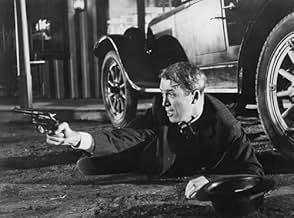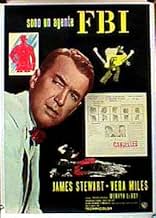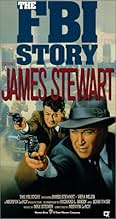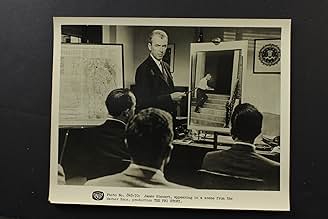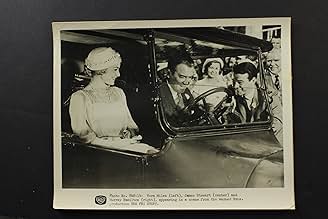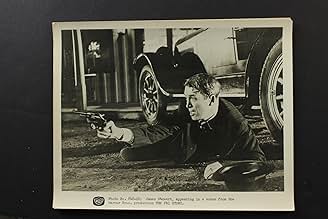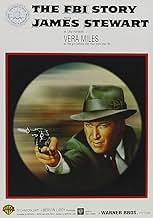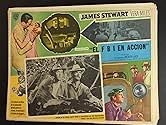IMDb रेटिंग
6.5/10
4.1 हज़ार
आपकी रेटिंग
अपनी भाषा में प्लॉट जोड़ेंA dedicated FBI agent recalls the agency's battles against the Klan, organized crime and Communist spies.A dedicated FBI agent recalls the agency's battles against the Klan, organized crime and Communist spies.A dedicated FBI agent recalls the agency's battles against the Klan, organized crime and Communist spies.
- निर्देशक
- लेखक
- स्टार
- पुरस्कार
- कुल 1 नामांकन
Ken Mayer
- Casket Salesman
- (as Kenneth Mayer)
Victor Adamson
- Train Passenger
- (बिना क्रेडिट के)
Luana Anders
- Mrs. Graham
- (बिना क्रेडिट के)
फ़ीचर्ड समीक्षाएं
When I was a very young teen, I saw this in the theater and was just awed. The different segments were very dramatic and stayed with me for decades.
So after a long, long absence, seeing this again in the late '90s turned out to be a major disappointment. As a kid, this movie was exciting, but it sure isn't now. It's two-and-a-half hours long and moves pretty well but too much time is spent on the marriage of Jimmy Stewart-Vera Miles ("Chip and Lucy Ann Hardesty").
As one who watches a lot of modern- day crime movies, it was odd to see one with absolutely no profanity in it and very little blood, but that's because it's a 1959 film. We see the FBI cracking down on the KKK, anti- Native Americans, the Communists, spies, etc. Some of those parts are exciting, but nothing like when it came out almost 50 years ago. Now, it's almost ho-hum stuff.
For me now, this movie is more of a nostalgia piece than anything else. Frankly, I doubt if I would watch it again.
So after a long, long absence, seeing this again in the late '90s turned out to be a major disappointment. As a kid, this movie was exciting, but it sure isn't now. It's two-and-a-half hours long and moves pretty well but too much time is spent on the marriage of Jimmy Stewart-Vera Miles ("Chip and Lucy Ann Hardesty").
As one who watches a lot of modern- day crime movies, it was odd to see one with absolutely no profanity in it and very little blood, but that's because it's a 1959 film. We see the FBI cracking down on the KKK, anti- Native Americans, the Communists, spies, etc. Some of those parts are exciting, but nothing like when it came out almost 50 years ago. Now, it's almost ho-hum stuff.
For me now, this movie is more of a nostalgia piece than anything else. Frankly, I doubt if I would watch it again.
An entertaining tribute to American law enforcement's most legendary force falls victim to Hollywood hokum, unrealistic dialogue, and choking piety regarding everything about the Federal Bureau Of Investigation, especially its founder, J. Edgar Hoover.
While Hoover is often referenced, sometimes heard, and even briefly seen at his desk, Buddha-like, the focus here is on fictional FBI agent Chip Hardesty (James Stewart), who dedicates himself to serving the bureau through decades of crime-fighting heroics. Whether ambushing John Dillinger or rounding up the Ku Klux Klan, Hardesty provides a case example of the heroism from which the FBI was made.
The final words of the film, superimposed on the screen over triumphant fanfare, establish what "The FBI Story" is all about: "Our sincere thanks to the FBI and J. Edgar Hoover not only for their guidance and active participation in the making of this motion picture but also for making this world of ours a safer place in which to live..."
If they had saved this boilerplate for the end, "The FBI Story" might have had a chance. Stewart was one of the greats, and in Vera Miles as the love interest he enjoys steady support. Few color films from the 1950s are this crisp- and dynamic-looking. Director Mervyn LeRoy was famously good at his job, and manages some stellar framing work with an eye for period detail in the episodic sequences showing Hardesty on the job at various stages of the FBI's existence.
But the accent of this film is not on delivering quality entertainment but burnishing Director Hoover's ego. At every turn, we get our noses rubbed into how brilliant an organization he set up, to the point where suspense gets crushed before it has a chance to develop.
An opening sequence features Nick Adams as a young man named Graham who kills his mother and 48 other people on board a plane by putting a bomb inside her luggage. Immediately we see FBI agents questioning him and searching his house until he cracks and confesses, even yelling at the end to send his mail to hell.
"Jack Graham's only mistake was that he was absent-minded," Stewart tells us in a voice-over. "He forgot about the broad research powers of the FBI."
Elsewhere we get lengthy descriptions of what these powers are, and even footage of people typing or staring into microscopes at FBI headquarters.
The dialogue in this film is much too purple, as if competing for your attention with Max Steiner's bombastic score. There are some howlers other reviewers here pointed out; my favorite is when Miles gets cross when she finds out her husband is going out armed to take on some public enemies. He tells her to take it easy.
"You take it easy, Chip! I don't look good in black."
Murray Hamilton has his own over-the-top moments as Chip's FBI buddy, all charged up with Hoover in charge. "I never wanna cool down," he says. No worries; a breathless script by Richard L. Breen and John Twist won't let him until it's time to stop and smell the lilacs.
There's one solid sequence where Hardesty investigates the murders of Osage Indians in Oklahoma. That works as a crime story with some mystery and humor to it, not to mention a satisfying wrapper.
The rest of the time, it's like some jacked-up medley of J. Edgar's greatest hits, like taking down bank robbers and a Soviet spy ring. Much padding involves Hardesty's family affairs, like his search for missing tissue paper or a crisis involving a shattered dish of pickles. Even when the script tries to drum up a crisis between Hardesty and his wife, the result is unconvincing and much-too-easily resolved.
That goes for most everything else involving "The FBI Story," rich in visual style but cheap in too many other departments, including the kind of patriotism too often used as the refuge of scoundrels. I do admire J. Edgar Hoover in some areas, but when it came to making movies, he should have stayed in the closet.
While Hoover is often referenced, sometimes heard, and even briefly seen at his desk, Buddha-like, the focus here is on fictional FBI agent Chip Hardesty (James Stewart), who dedicates himself to serving the bureau through decades of crime-fighting heroics. Whether ambushing John Dillinger or rounding up the Ku Klux Klan, Hardesty provides a case example of the heroism from which the FBI was made.
The final words of the film, superimposed on the screen over triumphant fanfare, establish what "The FBI Story" is all about: "Our sincere thanks to the FBI and J. Edgar Hoover not only for their guidance and active participation in the making of this motion picture but also for making this world of ours a safer place in which to live..."
If they had saved this boilerplate for the end, "The FBI Story" might have had a chance. Stewart was one of the greats, and in Vera Miles as the love interest he enjoys steady support. Few color films from the 1950s are this crisp- and dynamic-looking. Director Mervyn LeRoy was famously good at his job, and manages some stellar framing work with an eye for period detail in the episodic sequences showing Hardesty on the job at various stages of the FBI's existence.
But the accent of this film is not on delivering quality entertainment but burnishing Director Hoover's ego. At every turn, we get our noses rubbed into how brilliant an organization he set up, to the point where suspense gets crushed before it has a chance to develop.
An opening sequence features Nick Adams as a young man named Graham who kills his mother and 48 other people on board a plane by putting a bomb inside her luggage. Immediately we see FBI agents questioning him and searching his house until he cracks and confesses, even yelling at the end to send his mail to hell.
"Jack Graham's only mistake was that he was absent-minded," Stewart tells us in a voice-over. "He forgot about the broad research powers of the FBI."
Elsewhere we get lengthy descriptions of what these powers are, and even footage of people typing or staring into microscopes at FBI headquarters.
The dialogue in this film is much too purple, as if competing for your attention with Max Steiner's bombastic score. There are some howlers other reviewers here pointed out; my favorite is when Miles gets cross when she finds out her husband is going out armed to take on some public enemies. He tells her to take it easy.
"You take it easy, Chip! I don't look good in black."
Murray Hamilton has his own over-the-top moments as Chip's FBI buddy, all charged up with Hoover in charge. "I never wanna cool down," he says. No worries; a breathless script by Richard L. Breen and John Twist won't let him until it's time to stop and smell the lilacs.
There's one solid sequence where Hardesty investigates the murders of Osage Indians in Oklahoma. That works as a crime story with some mystery and humor to it, not to mention a satisfying wrapper.
The rest of the time, it's like some jacked-up medley of J. Edgar's greatest hits, like taking down bank robbers and a Soviet spy ring. Much padding involves Hardesty's family affairs, like his search for missing tissue paper or a crisis involving a shattered dish of pickles. Even when the script tries to drum up a crisis between Hardesty and his wife, the result is unconvincing and much-too-easily resolved.
That goes for most everything else involving "The FBI Story," rich in visual style but cheap in too many other departments, including the kind of patriotism too often used as the refuge of scoundrels. I do admire J. Edgar Hoover in some areas, but when it came to making movies, he should have stayed in the closet.
... and this little obscure piece of cinema history takes a book written about the FBI and turns it into two well told interwoven stories. One is the story of the life of one of the first FBI agents, the fictional John Hardesty (James Stewart) and his personal life through about 35 years as he marries and raises a family. The other is the story of the FBI from its infancy, told through the eyes and narration of Hardesty himself, covering several cases through the years including the Klan in the 20s, gangsters in the 30s, wartime espionage in the 40s, and then Communist espionage in the 50s. Vera Miles plays Hardesty's wife who does have her limits as the family is moved all over the country as Hardesty's assignments change.
One of the most interesting scenes to me is inside the Washington Bureau where dozens of women are in a big windowless concrete room filing stacks of correspondence by hand. That had to be mind numbing work.
I was surprised when I discovered the director was Mervyn LeRoy, because, although he directed some good ones over the years, he had a couple of bad habits. One was taking every single adapted play he directed and making it look like a play. In 1932 he actually changed scenes in one such film by having a curtain fall and then rise on another scene. The other bad habit was taking adapted books and have them play out like somebody is reading you the book - books on tape on film so to speak. This film, however, was done very well. But then I learned he and J. Edgar Hoover were friends, so maybe he had an extra incentive to have this one turn out well.
Agent Hardesty was certainly at the center of some big operations. The great irony of that being that J. Edgar was such a jealous guy that Hardesty would have spent a large part of his career in exile if he had been a real person with such a record of success. But then we would have no movie. So I found the secret to enjoying this film is to just forget about some of the actual truth that this film whitewashes over and enjoy it as an action/crime film of the time.
It can get a bit heavy handed and corny at times, but it holds up well due to the bigger than life talent of every man James Stewart.
One of the most interesting scenes to me is inside the Washington Bureau where dozens of women are in a big windowless concrete room filing stacks of correspondence by hand. That had to be mind numbing work.
I was surprised when I discovered the director was Mervyn LeRoy, because, although he directed some good ones over the years, he had a couple of bad habits. One was taking every single adapted play he directed and making it look like a play. In 1932 he actually changed scenes in one such film by having a curtain fall and then rise on another scene. The other bad habit was taking adapted books and have them play out like somebody is reading you the book - books on tape on film so to speak. This film, however, was done very well. But then I learned he and J. Edgar Hoover were friends, so maybe he had an extra incentive to have this one turn out well.
Agent Hardesty was certainly at the center of some big operations. The great irony of that being that J. Edgar was such a jealous guy that Hardesty would have spent a large part of his career in exile if he had been a real person with such a record of success. But then we would have no movie. So I found the secret to enjoying this film is to just forget about some of the actual truth that this film whitewashes over and enjoy it as an action/crime film of the time.
It can get a bit heavy handed and corny at times, but it holds up well due to the bigger than life talent of every man James Stewart.
In the tradition of G-Men, The House On 92nd Street, The Street With No Name, now comes The FBI Story one of those carefully supervised films that showed the Federal Bureau of Investigation in the best possible light. While it's 48 year director J. Edgar Hoover was alive, it would be showed in no other kind of light.
The book by Don Whitehead that this film is based on is a straight forward history of the bureau from it's founding in 1907 until roughly the time the film The FBI Story came out. It's important sometimes to remember there WAS an FBI before J. Edgar Hoover headed it. Some of that time is covered in the film as well.
But Warner Brothers was not making a documentary so to give the FBI flesh and blood the fictional character of John 'Chip' Hardesty was created. Hardesty as played by James Stewart is a career FBI man who graduated law school and rather than go in practice took a job with the bureau in the early twenties.
In real life the Bureau was headed by William J. Burns of the Burns Private Detective Agency. It was in fact a grossly political operation then as is showed in the film. Burns was on the periphery of the scandals of the Harding administration. When Hoover was appointed in 1924 to bring professional law enforcement techniques and rigorous standards of competence in, he did just that.
Through the Hardesty family which is Stewart and wife Vera Miles we see the history of the FBI unfold. In addition we see a lot of their personal family history which is completely integrated into the FBI's story itself. Stewart and Miles are most assuredly an all American couple. We follow the FBI through some of the cases Stewart is involved with, arresting Ku Klux Klan members, a plot to murder oil rich Indians, bringing down the notorious criminals of the thirties, their involvement with apprehending Nazi sympathizers in World War II and against Communist espionage in the Cold War.
There is a kind of prologue portion where Stewart tells a class at the FBI Academy before going into the history of the bureau as it intertwines with his own. That involves a bomb placed on an airline by a son who purchased a lot of life insurance on his mother before the flight. Nick Adams will give you the creeps as the perpetrator and the story is sadly relevant today.
Of course if The FBI Story were written and produced today it would reflect something different and not so all American. Still the FBI does have a story to tell and it is by no means a negative one.
The FBI Story is not one of Jimmy Stewart's best films, but it's the first one I ever saw with my favorite actor in it so it has a special fondness for me. If the whole FBI were made up Jimmy Stewarts, I'd feel a lot better about it. There's also a good performance by Murray Hamilton as his friend and fellow agent who is killed in a shootout with Baby Face Nelson.
Vera Miles didn't just marry Stewart, she in fact married the FBI as the film demonstrates. It's dated mostly, but still has a good and interesting story to tell.
The book by Don Whitehead that this film is based on is a straight forward history of the bureau from it's founding in 1907 until roughly the time the film The FBI Story came out. It's important sometimes to remember there WAS an FBI before J. Edgar Hoover headed it. Some of that time is covered in the film as well.
But Warner Brothers was not making a documentary so to give the FBI flesh and blood the fictional character of John 'Chip' Hardesty was created. Hardesty as played by James Stewart is a career FBI man who graduated law school and rather than go in practice took a job with the bureau in the early twenties.
In real life the Bureau was headed by William J. Burns of the Burns Private Detective Agency. It was in fact a grossly political operation then as is showed in the film. Burns was on the periphery of the scandals of the Harding administration. When Hoover was appointed in 1924 to bring professional law enforcement techniques and rigorous standards of competence in, he did just that.
Through the Hardesty family which is Stewart and wife Vera Miles we see the history of the FBI unfold. In addition we see a lot of their personal family history which is completely integrated into the FBI's story itself. Stewart and Miles are most assuredly an all American couple. We follow the FBI through some of the cases Stewart is involved with, arresting Ku Klux Klan members, a plot to murder oil rich Indians, bringing down the notorious criminals of the thirties, their involvement with apprehending Nazi sympathizers in World War II and against Communist espionage in the Cold War.
There is a kind of prologue portion where Stewart tells a class at the FBI Academy before going into the history of the bureau as it intertwines with his own. That involves a bomb placed on an airline by a son who purchased a lot of life insurance on his mother before the flight. Nick Adams will give you the creeps as the perpetrator and the story is sadly relevant today.
Of course if The FBI Story were written and produced today it would reflect something different and not so all American. Still the FBI does have a story to tell and it is by no means a negative one.
The FBI Story is not one of Jimmy Stewart's best films, but it's the first one I ever saw with my favorite actor in it so it has a special fondness for me. If the whole FBI were made up Jimmy Stewarts, I'd feel a lot better about it. There's also a good performance by Murray Hamilton as his friend and fellow agent who is killed in a shootout with Baby Face Nelson.
Vera Miles didn't just marry Stewart, she in fact married the FBI as the film demonstrates. It's dated mostly, but still has a good and interesting story to tell.
This movie is very well filmed for its age (1959), it is one of the better FBI movie's that actually portray it as the FBI should be portrayed, as the good guys, not the bad guys. Though it is one sided I think the point of the movie was to show the triumphs of the FBI. Jimmy Stewart was great in it!
क्या आपको पता है
- ट्रिवियाTwo FBI agents were on the set at all times.
- गूफ़Jennie forgets her speech at a mid-term Honor Society event. When her father comforts her in the family car a few moments later, the cherry blossoms are in bloom; this usually occurs in early April in Washington (DC). However, after they leave the car with the radio still on, a news bulletin breaks in, announcing the attack on Pearl Harbor, which took place on December 7, 1941. No cherry blossoms would have been in bloom then, nor would the weather have been mild enough as depicted in the accompanying scenes.
- भाव
[first lines]
John Michael Hardesty: [narrating] Webster's International Dictionary defines murder as the unlawful taking of human life by another human being. On a November evening in 1955, the definition became obsolete. A mass murder was being planned.
- कनेक्शनEdited from The High and the Mighty (1954)
टॉप पसंद
रेटिंग देने के लिए साइन-इन करें और वैयक्तिकृत सुझावों के लिए वॉचलिस्ट करें
- How long is The FBI Story?Alexa द्वारा संचालित
विवरण
- रिलीज़ की तारीख़
- कंट्री ऑफ़ ओरिजिन
- भाषा
- इस रूप में भी जाना जाता है
- Geheimagent des FBI
- फ़िल्माने की जगहें
- उत्पादन कंपनियां
- IMDbPro पर और कंपनी क्रेडिट देखें
- चलने की अवधि2 घंटे 29 मिनट
- पक्ष अनुपात
- 1.66 : 1
इस पेज में योगदान दें
किसी बदलाव का सुझाव दें या अनुपलब्ध कॉन्टेंट जोड़ें



